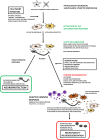Inflammatory Response in the CNS: Friend or Foe?
- PMID: 27889895
- PMCID: PMC5684251
- DOI: 10.1007/s12035-016-0297-1
Inflammatory Response in the CNS: Friend or Foe?
Abstract
Inflammatory reactions could be both beneficial and detrimental to the brain, depending on strengths of their activation in various stages of neurodegeneration. Mild activation of microglia and astrocytes usually reveals neuroprotective effects and ameliorates early symptoms of neurodegeneration; for instance, released cytokines help maintain synaptic plasticity and modulate neuronal excitability, and stimulated toll-like receptors (TLRs) promote neurogenesis and neurite outgrowth. However, strong activation of glial cells gives rise to cytokine overexpression/dysregulation, which accelerates neurodegeneration. Altered mutual regulation of p53 protein, a major tumor suppressor, and NF-κB, the major regulator of inflammation, seems to be crucial for the shift from beneficial to detrimental effects of neuroinflammatory reactions in neurodegeneration. Therapeutic intervention in the p53-NF-κB axis and modulation of TLR activity are future challenges to cope with neurodegeneration.
Keywords: Cytokines; Immune response in the CNS; Microglia activation; Neurodegeneration; Neuroinflammation; miRNA.
Conflict of interest statement
The authors declare that they have no conflict of interest.
Figures

References
-
- Waisman A, Liblau RS, Becher B. Innate and adaptive immune responses in the CNS. Lancet Neurol. 2015;14:945–955. - PubMed
Publication types
MeSH terms
Substances
LinkOut - more resources
Full Text Sources
Other Literature Sources
Research Materials
Miscellaneous

